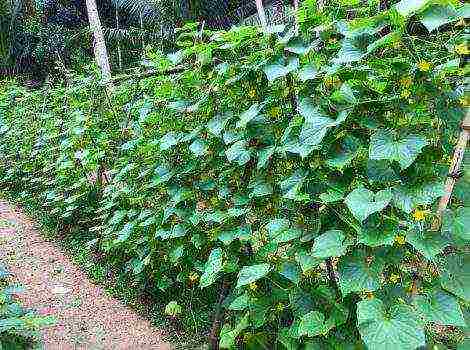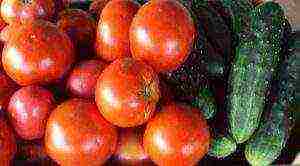Content [show]
Related materials:
Fish processing, Fish trade, Crayfish farming
Business relevance
Today, the markets of the city are in demand for fish products not only of large enterprises, but also of small private farms. Breeding fish makes it possible to save precious time - you need to spend only 3-5 hours per day for their care. Having received knowledge in the field of fish farming and organizing a reservoir, you can have a stable and high income.
Farming fish in artificial reservoirs as a business has little evidence of the risk of bad weather or seasonality. If you organize your business correctly, you can quickly recoup your investment and achieve a stable income.
Related videos:
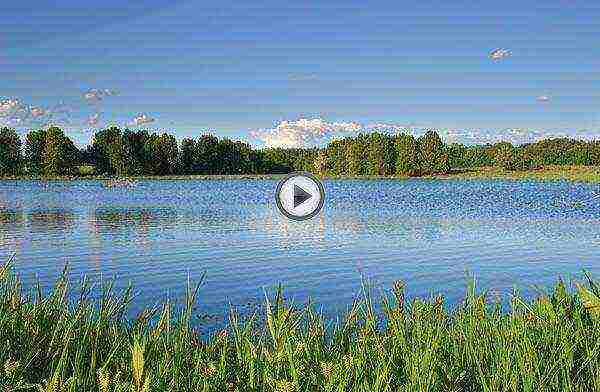
Tips for novice fish farmers
Development directions
At the present stage, fish farming is developing in several directions:
- Pond farming is the use of a separate reservoir for raising fish (suitable for a variety of species).
- Cage fish farming is important for large fish. The essence lies in the use of a part of the river, lake, reservoir, dividing the water space with cage lines.
- The basin method consists in raising fish in artificial reservoirs. Suitable for breeding pike, salmon, bream, perch, carp, etc. Some entrepreneurs create mini-reservoirs, which are low barrels or baths.
Related videos:

Basin cultivation method
Breeding sturgeon in the basement of a multi-storey building
What kind of fish is profitable to breed
Among the various types of fish, it is recommended to choose one that quickly gains weight, is unpretentious and resistant to diseases, and is also in demand among a wide range of the population.
Many experts advise newcomers to the fishing business to start with carp and trout, as these species are developing well and are in stable demand.
Carps quickly adapt to new conditions, are unpretentious to food, and are resistant to various diseases. Despite the low cost, the income after the sale of fish is quite high. For example, the profitability of the well-known enterprise OJSC "Biserovskiy Rybokombinat" is 9-10%.
The business plan for trout breeding is laborious and complex, since this fish is demanding and whimsical in terms of keeping conditions. For its cultivation, you cannot do without an experienced highly qualified specialist. But such advantages as an affordable breeding system, high product prices, excellent product taste, low maintenance requirements (compared to other salmonids) attract many businessmen.
Many farms breed silver carp. The advantages of this fish are that they can live peacefully with their "brothers" - grass carp and carp. Silver carp quickly gains weight, can reach up to a meter in height and 30 kilograms of weight.
Tench is an undeservedly forgotten subject of Russian fish farming. The fish gets along well with carp and crucian carp, is characterized by excellent taste. The meat is slightly sweet, tender, medium fat.Lin is resistant to many common diseases - dactylogirus, rubella, all sorts of parasites. Fish feel good in reservoirs overgrown with algae with a lack of oxygen.
Related videos:
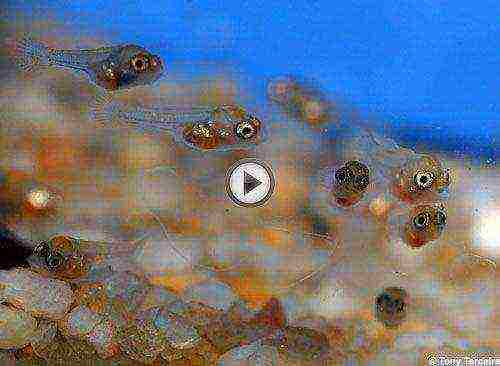
Food for fry. (Excellent food for fry of different types of fish.)
Artificial fish farming
The technology of growing fish in pools is a modern progressive version of the intensive development of aquaculture. Fish pools have been popular for decades, yet another way is to find the lowest point on your backyard, dig a pit, and build an artificial pond.
This option is beneficial, but very time consuming.
The bottom of the pond in the dacha for fish farming must be flat (holes can lead to waterlogging of the soil) and be isolated from groundwater ingress.
The insulating material can be:
- clay;
- sand;
- asbestos;
- concrete;
- expanded clay. Large farms make several types of ponds:
- spawning for hatching larvae from eggs;
- fry;
- wintering;
- adrenal;
- feeding.
Related videos:
Artificial breeding of trout
Closed water supply installations
Over the past decade, a new closed water exchange technology - RAS - has appeared on the Russian market. There is no need to rent large areas of land. Modern fish farms consist of a hangar-type room with several pools and equipment for water purification. The modular system of tanks allows keeping fish at a high stocking density (from 40 to 400 kg of fish per 1 m³). The feeding process is automatic. Fish in the given proportions receive dry granulated food, which enables them to gain weight and develop as quickly as possible. The water purification system directs it to all pools and removes pollution by saturating it with oxygen. This makes it possible to use water for a long time with small losses - up to 10%.
The advantages of RAS are obvious:
- refusal to discharge contaminated wastewater;
- economical use of water resources;
- the ability to grow fish and vegetables in one system and create a waste-free technology;
- ease of disposal of fish waste products;
- saving time for caring for fish;
- easy control of the dilution process - regulation of temperature, oxygen, light.
The only but significant drawback of RAS is the high cost of the system.
Related videos:
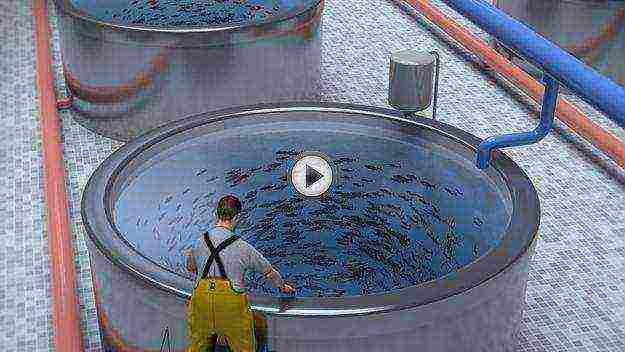
Farming fish in RAS
Basic feeding rules
For rapid growth, it is important to carefully consider the acquisition of fish seed. It is better to choose fry in fish farms. Before purchasing feed, check the manufacturer's certification, veterinary certificate and quality certificate.
Successful fish processing plants use industrial feed containing protein. Despite the high cost, the weight gain is doubled compared to conventional feed.
When feeding, you must observe the measure. The fish eats everything that is poured, but the hydrochemical regime of the reservoir will be violated if the proportions are violated. This will slow down development. The rate and types of feeding depend on the type of fish, temperature regime and conditions of detention.
Related videos:
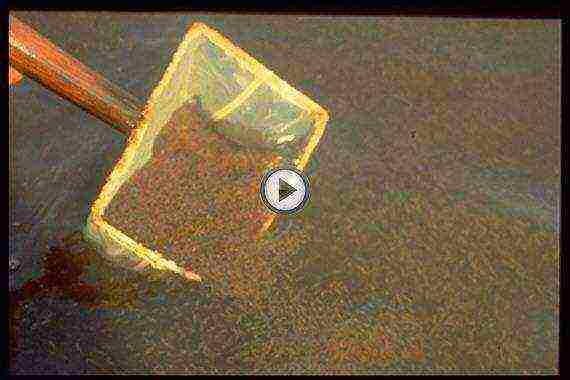
How to breed Artemia (Artemia is used as fish food in aquaculture and aquaristics.)
Business registration
The lack of domestic fish farming for sale lies in administrative barriers. It is not easy to obtain permission to rent a reservoir or part of it from local authorities, and a large package of documents is required.
But the laws of the Russian Federation do not prohibit the breeding of fish in the rate that are located on the territory of the land, which is private property. In other words, digging a pond on your own, installing a recirculating water system or pouring water into a quarry is much easier than working in a natural reservoir.
In this case, no permits are required.But stocking requires a veterinary certificate (epidemiological conclusion and fishery invoices). It is also necessary to register an individual entrepreneur or LLC with the OKVED code 05.02 "Fish farming".
Financial plan
Home-based fish farming as a business can be very profitable with proper planning and implementation of the idea. The cost of a project depends on its scale, development region, choice of fish species, technologies, etc.
If you open a mini-farm without hiring workers and saving on all aspects, the cost level will be distributed as follows:
1. purchase of fry - 300-500 rubles / kg. (when calculating, do not forget that 10% of them will not survive, and only 30-40% will be able to gain optimal weight);
2. Equipment with an artificial pool - from 6 thousand rubles. per piece;
3. purchase of feed - from 15 thousand rubles. per ton;
4. purchase of equipment for fish farming - from 50 thousand rubles.
The information provided in the article is only a brief introduction to the essence of business.
If you decide to move on to implementation, then you need to download a professional fisheries business plan with detailed calculations:
DOWNLOAD
Initial investments are from 150 thousand rubles. Add to this figure contingencies such as medical treatment. In general, fish farming is a profitable business, the main thing is to find distribution channels. It can be a restaurant, cafe and other catering establishments, as well as implementation at small or wholesale outlets.
Commercial offers
Bookmark the article. It will come in handy;)
Follow the updates on Facebook:
Attention!
The page publishes only reviews that are useful to others, which indicate that the person had experience in this matter.
Thank you very much in advance if you share your precious experience with our readers! :)
Having approached the formation of the pond correctly, having studied the parameters of the water and preparing everything for the launch of the fry, the owner will be able to grow the fish to the optimal size. Careful care and cleaning of the artificial reservoir will increase the number of fish for sale, and therefore increase the amount of profit.
The content of the article:
- Home fish farming from scratch
- Fish farming as a business at home
- Equipment for the reservoir
- Costs and technology of fish farming
- What is the best fish to breed?
- Growing fish at home on a mini-farm: how to organize it correctly?
At the moment, many experts in the field of fish farming consider the fish business to be quite a promising direction. Therefore, by creating conditions for its development, it is possible to solve the problem of providing the state with fish and help fish farms in such a difficult task as the cultivation of various fish species.
Previously, it was popular to breed fish in artificial reservoirs, but in this case, poachers prevented the growth and development of young animals and grown-up individuals, it is for this reason that fish breeders began to engage in organized reproduction and raising fish on mini-farms and at home. But in order for fish breeding to be successful, a novice fish farmer needs to study the breeding instructions and adhere to all the prescribed rules. Without what, domestic fish farming will not bring the desired results?
Home fish farming from scratch
The most important resource for raising any type of fish is water. The growth, development and health of young animals will depend on its quality.
Step one. Creation of an artificial reservoir.
Before proceeding with the creation of a pond, it is necessary to devote time to a complete analysis of the water, having studied all the indicators and quality standards necessary for settling the reservoir with new residents.
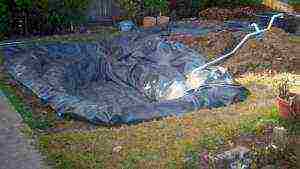
For this purpose, it is best to contact Surveillance and ask specialists to carry out the necessary analyzes of the aquatic environment and give advice on improving it, if necessary. If the water quality is not up to standard, do not despair. It is enough to carry out aeration and cleaning of the pond and everything will return to normal.
Step two.Determination of the quality of water resources.
The water in the fish pond must necessarily have the following characteristics:
- Optimal salt ratio;
- Regular and irregular temperature conditions;
- The total number of microorganisms living in it and PH;
- General transparency;
- The presence of minerals necessary for future fish;
- Color qualities;
- The ratio of gases dissolved in water;
If all these characteristics correspond to the stated standards, then it will be possible to grow fish without any problems.
Step three. Launching fry.
Before you start the fry into the reservoir, you need to know what temperature regime is suitable for the fish species you have chosen. There are fish that are more suitable for cold water, and there are fish breeds that will only feel comfortable in warm water.

Cold-loving breeds include grass carp, carp, catfish, crucian carp, sterlet, silverheads, trout, peled and salmon. Heat-loving fish need to ensure the water temperature is not lower than twenty degrees, and for those who prefer cool waters from ten to twenty degrees. Wintering in the reservoir will also be determined by fish species.
Step four. Stages of fish growing.
In order to properly build your mini fish farm, you need to know that breeding stages are taken into account when growing fish. First, the fish spawn, then fry appear, then the wintering stage follows, the next stage of growth, and experienced fish farmers consider the feeding stage as the last step.
Taking them into account, it is possible to clearly distinguish between these periods and create the necessary scheme for the growth and development of young animals and reared individuals. For each of these stages, it is best to equip your own pond or use plastic pools.
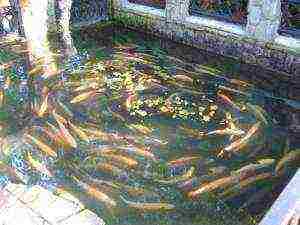
In the pool or pond for spawning, fish farmers are engaged in removing fry from eggs. The hatched fry are transplanted into a pond where they will grow. Upon reaching a certain age, they are placed in a growing reservoir, where they will gain weight. When the generation grows stronger and it will no longer be possible to worry about its health, it is transferred to a feeding pond, and for wintering a special wintering reservoir is used with conditions appropriate for fish.
In order for the fish to grow and develop well, the water in the reservoir must be clean and enriched with oxygen. Also, it should not contain hydrogen sulfide and methane. To avoid their appearance, the pond must be created in an appropriate area, which can be determined using a geodetic map. Also in the reservoir there must be appropriate vegetation, which will saturate the water with substances useful for fish.
Step five. Feeding.
Not only does water play an important role in fish farming, but also the use of appropriate feed additives. In order to grow healthy fish, it is necessary to use feed mixtures appropriate for each breed. They consist of fats, fiber, legumes, grains, proteins, minerals and vitamins that fish need. The secret of success is simple: in order for the fish to grow well, fish farmers fertilize the reservoirs and mineralize them.

For each age of fish, it is necessary to use its own feed additives, as well as to raise immunity, use therapeutic stress food, which helps the fish to cope with the disease and gain immunity to it. That is, in principle, all that is necessary to know for fish farmers who decide to grow fish at home.
Fish farming as a business at home
The most important thing for growing fish is water, without it it will simply not be possible to breed any of the fish species. It is for this reason that, before deciding to grow fish at home, it is necessary to build an artificial reservoir suitable for it.
For this purpose, you can rent a state reservoir, but this idea is better to leave.Because it will take you a lot of time to obtain various permits and approvals, and in addition to all this, your "fishing spot" will also be threatened by poachers trying to catch as much fish as possible in your reservoir. For this reason, it is best to forget about renting a pond from government agencies. Moreover, the cost of a business based on state lease will be very expensive for you.
Another option is to create an artificial pond in your country or summer cottage. The creation of an artificial reservoir will also cost a lot, but it will still require much less material and nerve costs from you, and you will also be one hundred percent sure of the reliability of your business.
If you want to breed fish for which fresh water is good, then you can use a polycarbonate greenhouse with a plastic pool installed in it. It also needs to purchase compressor and filtering equipment, which will cost the lack of three thousand dollars. If you can create such equipment yourself, you can significantly reduce the cost of equipment for the reservoir. But before you start creating or purchasing it, you need to find out what kind of equipment and materials you need.
Equipment for the reservoir
Purification of water in a reservoir should be carried out using a gravity filter. It is quite simple to install and it will not take much of your time. It costs about five thousand rubles. It is used not only for water purification, but also allows you to remove microorganisms that cause water bloom and ooze.
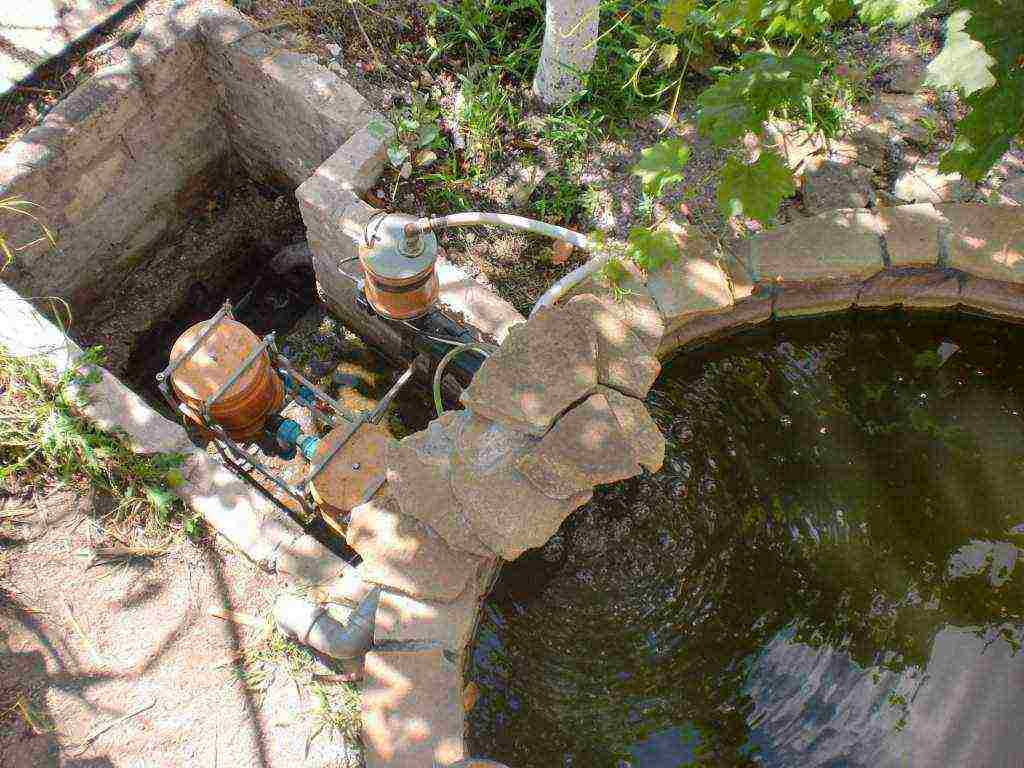
In order to saturate the water with oxygen, compressor equipment is used. Its cost can reach ten thousand rubles. In order to prevent the water in the reservoir from blooming, sterilizers with ultraviolet diodes are used. To pump water out of the reservoir, you need to purchase a hydraulic pump (about five thousand rubles). You can also do it yourself by collecting it from the tubes. In this case, the reservoir will be filled with water from underground sources and springs. Feeders can be purchased at tackle stores. Also, do not forget about the drainage equipment.
Costs and technology of fish farming
The benefits of fish farming are clear. On the market, take, for example, a sturgeon, a kilogram costs about two hundred rubles. Buying fry or breeding them yourself, you can get up to a ton of fish per year, which is about one and a half thousand kilograms, which means three hundred thousand rubles.
Having spent one hundred and fifty thousand on your fishing business, you can work out the costs for a year and still make a profit. The main thing is to find points of sale and then you don't have to worry about profit.
Of course, only those people who understand all the risks and are ready to take them can engage in fish farming, because this type of business is quite competitive. And if you are not ready to fight and breed really high-quality and selective fish, it is better not to start it.
And now, finally, you have made a firm decision to create your own fish farm. What documents do you need? Since you will be starting a business, you will need to register your business. This will also require additional costs. You will also need a license to grow fish, which you will need to issue. And when you get the first "harvest", you still have to go through product quality control and obtain a special permit from the relevant structures.
What is the best fish to breed?
While the cost of creating an artificial reservoir is easy to calculate, the cost of purchasing and raising fish is very difficult. It is for this reason that a clear business plan must be drawn up.
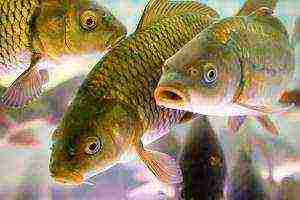
The most unpretentious fish in food and maintenance is carp. It is also affordable and affordable.When purchasing a ton of carp fry, you will need to spend about a thousand dollars. Moreover, this fish breed will not begin to multiply immediately, but only after three years. In addition, carp grow twice as slow in the cold season.
In industrial terms, the most profitable fish species are considered to be all varieties of sturgeon. An adult sturgeon weighs an average of five hundred grams. A kilogram of sturgeon at wholesale will cost about ten dollars. In your artificial pond, you can grow about a ton of such fish in six months. And this means that this business can really be called profitable.
Growing fish at home on a mini-farm: how to organize it correctly?
If you follow all of the above tips, then growing fish in your pond or pool is not a problem. This is exactly what the farmer Mikhail Atamanov, who grows sterlet and trout on his farm in Yaroslavl, does. He grows and sells up to ten tons of fish per year and is not going to stop there. According to him, such a business brings him not only tangible profit, but also pleasure.
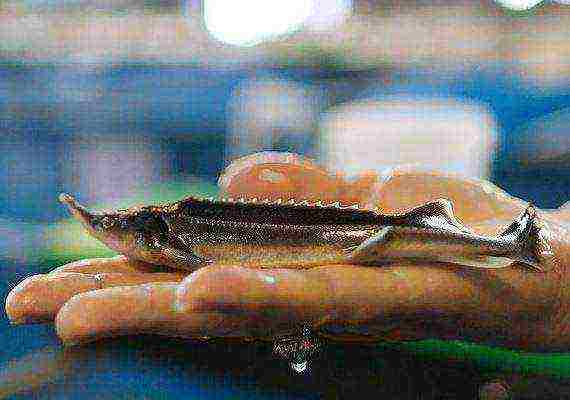
The fishing business in our country is exactly the niche that makes sense to occupy, since this direction is not yet developing actively enough.
Meanwhile, more and more people prefer fish over meat from birds and mammals. Partly because fish meat is dietary, partly because of moral considerations - the number of vegetarians in the world is increasing every year.
The cost of fish in our country, in comparison with other countries, is quite expensive - this is due to the cold climate and the corresponding difficulties in breeding.
Someone does not want to accept live fish, someone pays for the goods only after the sale - these the nuances must be reflected in the resume when drawing up a business plan for fish farming.
How to start a home fish farm?
It is worth noting that raising fish is not at all as easy as it seems at first glance. Some breeders admit that it is even more troublesome than pigs or poultry.
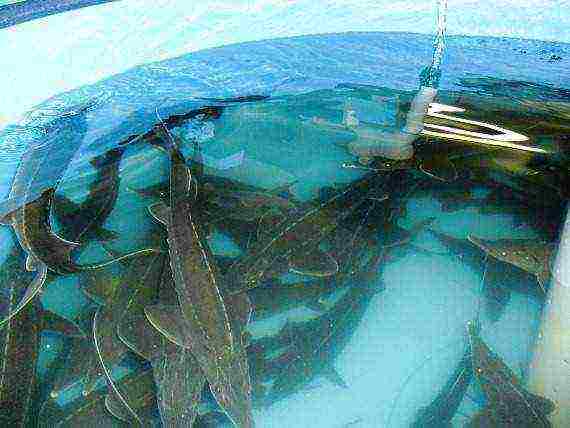
Unpretentious, at first glance, creatures, in fact, require constant care and attention, control over the temperature of the water, proper feeding and monitoring the ecosystem of the reservoir as a whole. The health status of individual fish should be checked regularly because a viral disease can quickly spread to the entire pond.
First of all, it is preferable for this business to have established points of sale. Practice shows that problems with buyers in the fish business arise very often, especially when it comes to chain stores.
If you decide to seriously plunge into this area, you should be prepared for a large investment of time and effort. Neglect in relation to these minor factors will lead to dire consequences.
It might make sense to hire an assistant or do business with the whole family.
Arrangement of a reservoir
- To create a fish farm, many people prefer rent a pond.
This is really beneficial as, in addition to direct breeding, it can be used as a paid fishing space. But at home, this is not always possible.
- As a less costly alternative often use swimming pools.
They are good because they are equipped with devices for adjusting the water temperature, oxygen level and other indicators. And in general, it is much more convenient to watch the fish in them: you can track emerging diseases, protect the "baby" from the attacks of predators.
- The third option is creation of your own small ponds in the garden.
This path is attractive because it is easy to plant plants in such a reservoir, which will later serve as food for fish. In this case, there is no need to constantly take care of the feed yourself and calculate its amount.The pond arrangement, moreover, is more economical - after all, the cost of the pools is quite tangible.
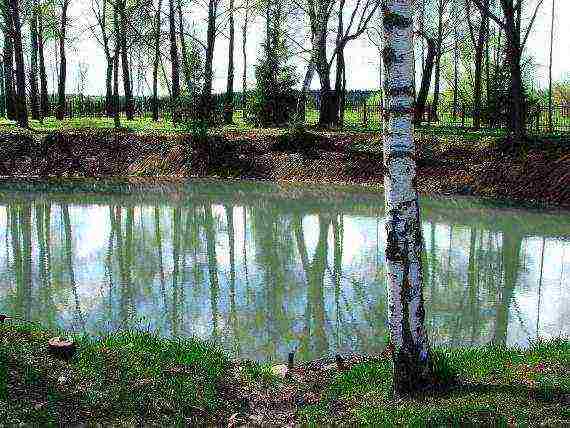
The issue of feeding is of fundamental importance, since overfeeding fish is harmful not only for their development - the remnants of rotting food in the reservoir do not contribute to a favorable microclimate for the entire ecosystem.
To equip a reservoir on the site, it is necessary to dig a pit and provide a bottom layer. For this, clay, asbestos, expanded clay and sand are alternated. You can also use concrete as a covering, and pour soil on top.
The only disadvantage of an artificial pond: it is advisable to plant plants at least three months before the appearance of fish in itto form the desired ecosystem. Otherwise, if you start the inhabitants earlier, you will have to feed them yourself for some time. For the winter period, it is better to clear the pond from vegetation.
The disadvantage of natural reservoirs is that the water there often does not warm up enough, and when the fish is cold, it stops gaining weight, and the food is wasted. Pools are able to solve this problem almost completely.
Choice of direction
It depends on many factors: region, climatic characteristics, interests of buyers, etc.
What kind of fish to choose for business is up to you:
- Carp is considered one of the most profitable breeds for breeding - it is not too whimsical, and the meat of this fish has an extraordinary taste.
- Trout on the market is valued three times higher, but more effort will be required from you: this fish is unusually fastidious in care.
- Other species are also bred - tench, sturgeon, pike, etc.
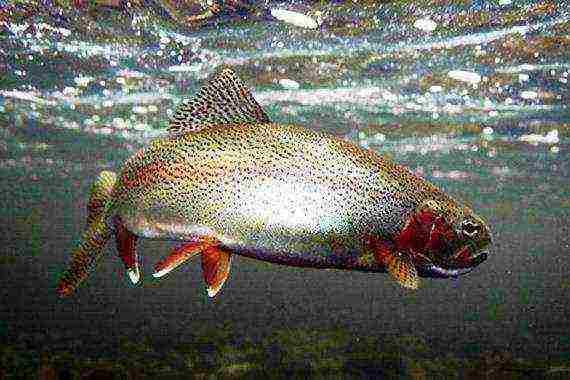
The first two types of fish are mainly in demand. When choosing, you also need to remember - the larger the fish, the more it is in demand on the market, and the higher your future profit.
However, it is worth remembering that keeping different-colored fish in the same reservoir is not always possible: these creatures have their own hierarchy, and it is better to avoid collisions as much as possible.
Is it profitable to engage in this branch of animal husbandry?
While ensuring normal growth, established sales and active sales, a fish farming business can be very cost effective.
But to achieve such a result under the current conditions is not too easy for several reasons:
- Compared to the 90s, the demand for fish in Russia has dropped noticeably; many people cannot afford to buy it.
- Another a significant disadvantage is a fairly long payback.
Fish grows extremely slowly, and some species even throughout their life. It takes three years for carp to reach their maximum weight, and two and a half years for trout. Not every breeder is ready to wait that long, so some buy "young", although it costs much more than buying fry, but here you have to choose. - The "capriciousness" of the fish also has its own meaning.
For example, carp can be very well fed on special ready-made mixtures, but the taste of the meat will leave much to be desired.
For the fish to be tasty, it needs a lot of attention and a special diet.
Fish can lose its taste, including due to improper maintenance during transportation. In this case, the buyer has the right to return the entire batch, declaring it a "marriage".
On the other side, high fertility of fish and excellent profitability with established channels can compensate for all the disadvantages.
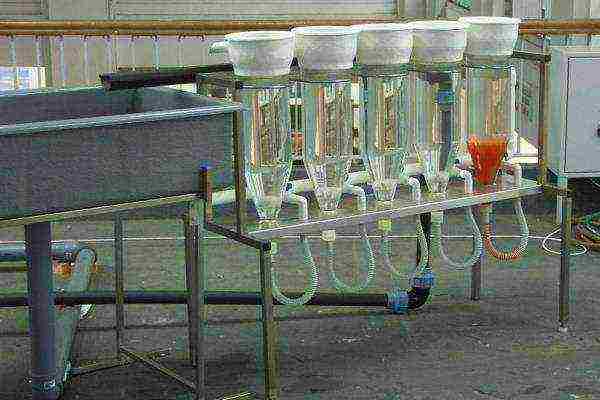
Farm equipment
If you decide to breed fish in pools, for this you will need a room with an area of 50 sq.m.... It must be well heated and equipped with electricity and running water.
You can use containers of different depths: many small pools (about 1 m deep) or several deep ones. But it should be borne in mind that the larger the volume of "dwelling" for fish, the more power grid you need to operate the equipment.
To equip swimming pools, you need the following:
- Pumps for pumping water;
- Filters that purify water from microbes and impurities;
- Oxygen generators;
- Thermometers and other devices for monitoring temperature, water level, etc .;
- Incubator. If you have it, you will be able to purchase not fry, but caviar, and breed offspring on your own, thanks to which you can save a lot.
At the very beginning of the activity, it is better to try to save on equipment - for example, use not inflatable pools, but plastic containers, or even self-made ones.
In the future, after the payback of the project, you can think about more expensive equipment: special pools, automatic feeding systems, etc.
According to experienced entrepreneurs, significantly increases the profitability of the business using fish hatchery modules... Growing fry in this case takes place in special containers equipped with tap systems for collecting and draining water, aeration, filtration and UV sterilization.
For the experience of using production fish farming modules for organizing a sturgeon farming business, see the video:
Approximate financial plan
Provided you're running a small home farm that doesn't outsource labor and keep costs to a minimum, you can end up with the following business plan:
- Fry - 300-500 rubles per kg.
When deciding on the number of fry, keep in mind that approximately 10% will die and only 30% will be able to gain full weight. Accordingly, if conditions permit, it is better to purchase as much as possible. - Swimming pool for growing fish - from 4 thousand rubles per piece;
- Pool equipment - from 50 thousand rubles;
- Compound feed for fish - from 10 thousand rubles per ton.
With maximum savings at the start-up stage, you can keep within 100 thousand rubles.
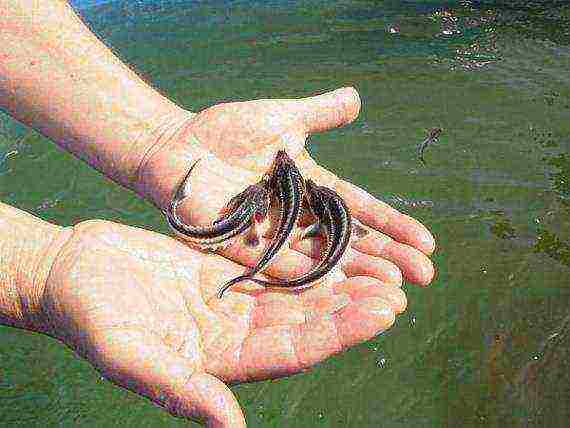
It is important to remember that trying to save on fry and, for example, catching them in a pond is not a good idea. There is a great risk that the fish will be sick.
In the future, also it is worth considering the possible unforeseen costs, for example, for treatment.
The average market value of a kilogram of fish is 200 rubles.
By purchasing fry for 15 thousand rubles, you can get a ton of meat per year from one cubic meter of water, thus leaving annual profit of 200 thousand rubles.
The business is profitable, but one should not forget about its long payback period. However, the wait is worth it in order to subsequently regularly receive a stable profit.
If you find an error, please select a piece of text and press Ctrl + Enter.
Pond fish farming as a business is not the easiest thing to do, but it has a good profitability.
Russia is a country rich in natural resources. It ranks second after Brazil in terms of water reserves. A large number of reservoirs with fresh water allows for fish farming. This type of agriculture is currently underdeveloped among modern entrepreneurs, largely due to serious competition with foreign fish suppliers.
From the point of view of profitability, fish farming in a pond allows you to get about 20% of the net profit. This business can be done both in the southern and northern regions of the country. More preferable is the Krasnodar Territory zone.
In this article, we will consider the features of fish farming in a pond, find out why this particular breeding format is the most preferable, calculate the profitability, study cultivation technologies, information on feeding.
Fish farming methods
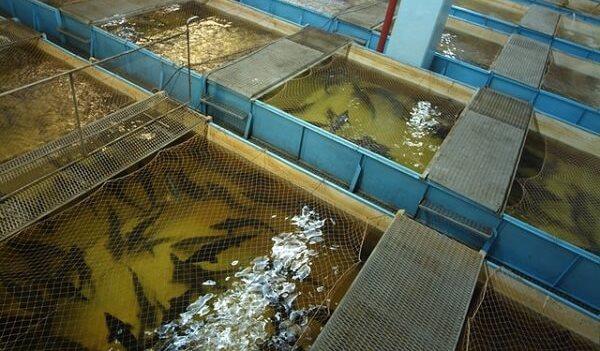
There are 2 directions of fish farming - in artificial and natural reservoirs. The latter option is rather difficult to implement due to serious administrative barriers. Renting a pond is not easy. It will take time to collect papers, carry out approvals. And you can get the right to rent a specific reservoir only after winning a competitive bidding.
If an entrepreneur does not want to engage in all this paperwork, then he can independently create an artificial reservoir for keeping fish. Today it is grown in one of the following ways:
- in ponds (allows you to grow a large number of fish, including different types, is distinguished by a high level of profit and lower cash costs);
- in swimming pools;
- cage breeding (usually this method is used for breeding large individuals);
- breeding in barrels and tubs (almost always does not imply the possibility of making a large profit).
Businessmen who have decided to seriously engage in fish farming stop at raising fish in a pond. This is the most promising and profitable method.
What is the best fish to grow?
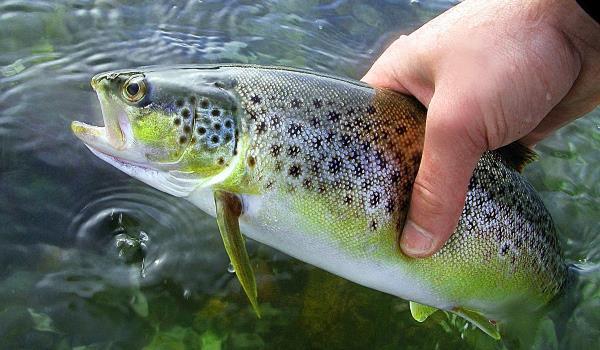
Before choosing a place to breed fish, you need to decide what kind of fish to breed. The most demanded in the sales market today are:
- trout;
- carp.
The ideal option is to grow fish of these two varieties at once. But it is only available if you have a fairly substantial initial capital. If this is not possible, then the following features should be taken into account:
|
pros |
Minuses |
|
|
Carp |
It grows quickly, does not require special conditions for breeding, and can multiply in many bodies of water. |
Significantly lower cost per kilogram than trout. The need to sell more than trout. |
|
Trout |
High cost per kilogram (can reach 140-250 rubles). |
Large costs of care and maintenance, the need to study the nuances of growing, serious requirements for a reservoir for successful breeding of trout. |
As you can see, both breeding formats have their advantages and disadvantages, so the breeder must make the final decision himself, assessing the level of his knowledge, start-up capital and responsibility.
Choosing a place for fish farming
Surely even novice fish breeders know that the rate of increase in the number and mass of individuals, as well as their health, depends on the level of water temperature and its acidity. It is rather difficult to assess these factors on your own, therefore it is better to use the services of a specialist who can give a fish-biological justification at the end of his work.
The choice of location directly depends on the type of fish. For example, trout thrive in temperatures between 160C and 190C. It is better to keep it in a reservoir with a depth of at least 15 meters.
But carp is more thermophilic. It must be kept at a temperature of 240C - 250C. They do not require great depth. One and a half meters will be enough.
It is better to breed any fish in a drainage pond, so it will be much easier to collect individuals for further sale.
Features of fish farming in a pond
If the entrepreneur has already decided that he will breed fish in the pond, then he has several more unresolved questions. He must:
- choose a growing method;
- properly equip the reservoir;
- purchase the necessary inventory;
- develop a food system in accordance with the recommendations of more experienced businessmen in this field.
The growth rate and further productivity of adults will depend on the amount of food, the correctly selected climatic zone and the quality of water.
Fish farming method
The growth rate of fish depends on the conditions and place of residence. If it is contained in a pond, then it takes about 1.5–2 years to grow. This is how long it takes a fish to reach a significant mass. To breed individuals in a pond, you can use one of the following methods:
- extensive (fish eats food from a reservoir, no additional additives are used) - almost does not require current investments from a businessman;
- intensive (reclamation of the reservoir is carried out to enrich the feed, additionally purchased feed is used) - requires more investments than in the first method, but it allows you to increase the growth rate.
In addition to methods, there are also several technologies for fish farming: traditional and continuous.
The traditional format consists of a 2 to 3 year growing cycle.This technology is used for breeding exclusively herbivorous fish. This technique is not so common today, as it takes a long time. It consists of several stages, ending with the release of water from the pond. In this case, it is necessary to use several types of ponds - wintering, feeding, fry. During the transfer of fish, their high mortality is observed.
Increasingly, fish breeders today are using continuous technology because it is much easier to apply. According to this method, young animals are raised separately, and then planted in a feeding pond for their further growth and reproduction.
Features of the selection of a site for creating a pond
Fish farming is possible not only outside the city, but also within it, provided that you have your own large plot. The presence of plants in the pond is a must. In no case should there be peat and silt at the bottom. It is important to make sure in advance that the reservoir is suitable specifically for growing and incubation, and not just keeping individuals.
The decorative elements of the pond can be chosen at your discretion, but during the construction, the following tips from more experienced entrepreneurs engaged in fish farming should be considered:
- the most suitable pond volume is from 30 to 50 m2, a smaller pond will need to be carefully monitored, and a larger pond will result in serious costs;
- you need to place a pond in a low-lying area;
- there must be a shade so that the fish can take refuge in it during the hot season;
- it is better not to make a flat bottom, but to make sections with thresholds, ledges;
- each type of fish requires the creation of a reservoir with different types of soil.
What equipment is required?
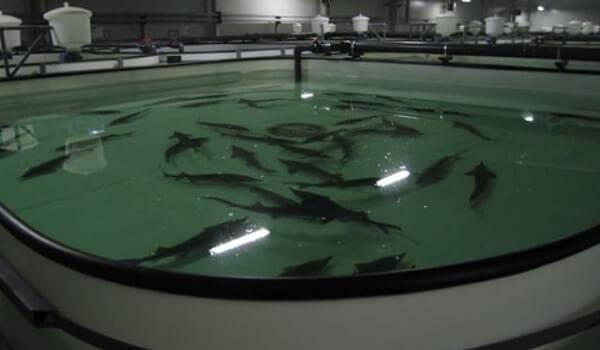
When breeding fish in an artificial pond, it will not do without special equipment. An entrepreneur will need:
- gravity filter (will filter water, easy and convenient to use);
- compressor (will saturate the water with oxygen);
- ultraviolet sterilizer (will not allow the reservoir to bloom).
In addition, other devices may be needed, here everything will already depend on the type of fish being grown.
Diet
One of the most important factors in fast growth is proper feeding of the fish. There is no one-size-fits-all solution. It all depends on the species grown, because each variety has its own food preferences, it grows to a certain size. Of course, much depends on the conditions of detention. If a businessman wants to accelerate the growth of individuals, then food rich in protein should be added to food.
Fish do not require a lot of food. So, to increase the mass by 1 kilogram, the diet must have a value of at least 4,500 kcal.
It is important to monitor the amount of amino acids in food, as they induce appetite and directly affect the rate of mass gain. It also prevents many diseases in fish, especially fry.
A healthy diet must also include:
- vegetable and animal fats;
- fiber (the amount of its consumption depends on the type of fish being farmed, the minimum amount is 20%, for some species this value may be higher);
- biologically active substances (these can be enzymes or premixes);
- cereals (for example, you can add bran to the feed, they will be an excellent source of carbohydrates);
- vitamin B;
- meat products (special flour, low-fat dairy products).
Such a balanced diet will allow the fish to grow quickly and maintain their health and reproduction.
Disease as a cause of high fish mortality
Sometimes entrepreneurs underestimate the impact of disease on reproduction rates and mortality rates. But when breeding fish in a pond, the risk of disease is very high. That is why it is necessary to check the condition of individuals at least once every 10 days. The following diseases are most common in freshwater fish:
|
Name of the disease |
Symptoms of the disease |
|
Rubella |
Bulging of the eyes, the skin is inflamed, dropsy begins, minor hemorrhages appear. |
|
Gill rot |
Dying off of the edges of the gill tissue, pallor of the gills. Large individuals refuse to eat, become inactive. |
|
Discocotiliasis |
The gill tissue is injured. The disease is especially dangerous for young animals. |
|
Ichthyophthyroidism |
White bumps appear on the body. |
|
Dactylogyrosis |
Decreased level of activity, exhaustion, anemia of the gills, drooping eyes. Usually manifests itself during the hot season. Young individuals are most susceptible to this disease. |
Fish distribution channels
Farmed fish are fairly easy to sell. Most often, entrepreneurs use the following sales channels:
- fish shops and kiosks;
- supermarkets and small shops;
- restaurants;
- sale to local residents;
- Internet trade.
To be eligible to sell fish, you must register officially. It is better to choose the unified agricultural tax as a form of tax.
Influence of the seasonality of a business on its payback and financial results
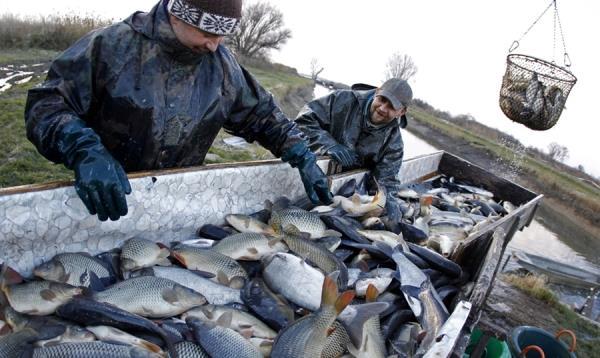
Pond fish farming is a seasonal business. The peak of growth activity occurs in the spring and summer. But even in winter, individuals need to be looked after: feed them, make holes on the ice. Fish are usually sold in the autumn.
The cost per kilogram of fish will depend on the season of sale. The lowest prices will be in September, October and November. But in the remaining months, the cost will be slightly higher, which will allow you to get a higher profit for the sale of the same amount of fish.
It is the seasonality in this area of entrepreneurship that is its main drawback, which negatively affects the development of individual farms. Real income is possible for only 3-4 months. All other periods of time will need to be invested.
So that the enterprise does not turn out to be unprofitable, it is necessary to think over all the nuances in advance, draw up a detailed business plan with accurate calculations. We must not forget that the level of competition in this area is very high, so working in the fishing industry is worth those who are confident in their abilities and are ready to work for the result.
Due to the presence of seasonality, it will not be possible to return your investments quickly. The payback period can reach 6-12 months. And without special knowledge in the fishing industry, you can even go to the minus.
The main cost items will be:
- purchase of fry;
- purchase of feed and all kinds of additives to them;
- purchase of special equipment;
- costs for the arrangement of the pond and its maintenance.
It is possible to hope for high incomes only in the case of proper maintenance and care of fish, a constant increase in their number. This format of entrepreneurship requires special attention from a businessman or hired staff.
